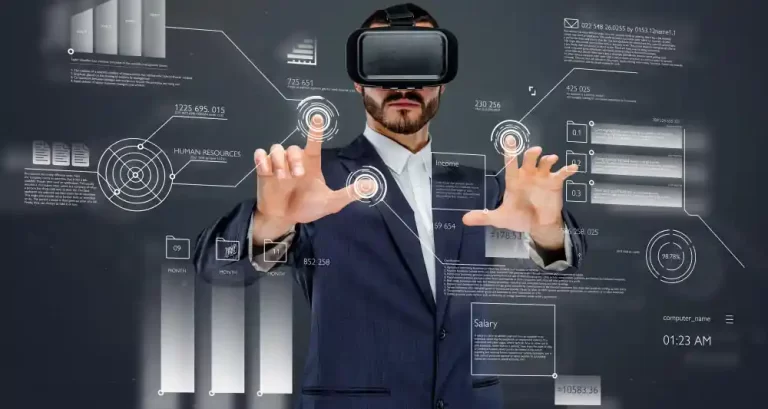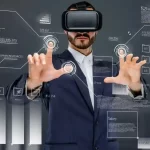Introduction
Since its inception in the late 1960s, the Internet has advanced significantly. It now forms a vital component of modern life, linking businesses and individuals worldwide. What does the future of the Internet hold, though, as technology continues to advance at an alarming rate? The way we interact, work, and live has been completely transformed by the internet. But if technology develops further in the future, we can anticipate even more changes.
The Internet of Things
The ability of common things to connect to the Internet and share data is referred to as the “Internet of Things” (IoT). This covers everything from medical equipment and fitness monitors to smart door locks and thermostats.
The goal of the Internet of Things is to build a network of interconnected devices that can communicate with one another and the Internet, enhancing automation and efficiency across a number of industries. IoT devices, for instance, may be used in smart homes to alter lighting and temperature based on tenant preferences, while IoT sensors could be used in factories to monitor machine performance and identify possible concerns before they become significant issues.
The ability to gather and analyse massive volumes of data, which can be utilised to acquire insights and make wise decisions, is one of the primary advantages of the IoT. For instance, a city might deploy IoT devices to track traffic and air quality in real-time, enabling better urban planning.
Despite these issues, it is anticipated that the IoT will continue to gain popularity in the years to come. Over 75 billion Internet of Things (IoT) devices are predicted to be in use globally by 2025. In order to make sure that the advantages are balanced against the hazards, this has the potential to revolutionise sectors like healthcare, transportation, and agriculture.
5G Networks

The most recent wireless communication technology, known as 5G, has greater capacity, reduced latency, and quicker speeds than earlier generations. It is intended to support a broad range of novel use cases and applications, including automated cars, virtual reality, smart cities, and industrial automation.
The speed of 5G is one of its major advantages. Up to 20 Gbps of download speed can be delivered, which is 20 times faster than 4G. This translates to consumers being able to download and use bandwidth-intensive applications fast and easily, as well as stream high-quality video.
Low latency, or the amount of time it takes for data to move between a device and a network, is another crucial aspect of 5G. Compared to the 20–30 milliseconds of 4G networks, the latency of 5G networks is only a few milliseconds. This implies that real-time, lag-free operation is possible for programmes like virtual reality and driverless vehicles.
In addition to speed and low latency, 5G delivers more capacity than earlier wireless technology generations. This makes it possible to link everything from smartphones and laptops to smart home gadgets and industrial equipment since networks can accommodate a significantly larger number of users and devices.
The introduction of 5G networks has prompted questions about the technology’s potential threats to safety and health, though. Despite the lack of supporting scientific data, some people worry that the high-frequency radio waves employed by 5G networks may be detrimental to human health.
Despite these worries, 5G networks are anticipated to become more significant over the coming years. They have the ability to open up new applications and services, spur innovation across a number of industries, and enhance how people interact with one another.
Artificial Intelligence

Artificial intelligence (AI) is a branch of computer science that focuses on creating devices and programmes that can carry out operations that ordinarily call for human intelligence. Speech recognition, image processing, decision-making, and problem-solving are all included in this.
AI systems are made to grow increasingly accurate and effective as they analyse more data and learn from their mistakes. They are designed to learn and adapt over time. They may therefore be used to analyse huge amounts of data and spot patterns that would be challenging or impossible for humans to see in applications like natural language processing and machine learning.
Automating repetitive jobs allows humans to focus on more creative and strategic work, which is one of the main advantages of AI. AI systems, for instance, can be used to automate financial data analysis, news article writing, and customer care interactions.
However, the advancement of Artificial intelligence also brings up ethical questions and worries about employment displacement. There is a chance that many jobs will be automated as machines grow more adept at carrying out tasks currently done by people, which could result in large employment losses in some sectors.
Concerns have also been raised concerning the possible abuse of AI systems, particularly in fields like cybersecurity and spying. AI systems run the possibility of being utilised for evil intent, such as cyberattacks or even warfare, as they grow more potent and intelligent.
Despite these worries, it is anticipated that the significance of AI will only increase over the next few years. It has the potential to completely transform a variety of sectors, from manufacturing and transportation to healthcare and banking. To make sure that information is utilised in a way that benefits society as a whole, it will also require careful administration and control.
Blockchain

Blockchain is a type of digital ledger technology that makes record-keeping safe, open, and decentralised. Although it has numerous other possible applications in industries like finance, healthcare, and supply chain management, cryptocurrencies like Bitcoin are where it is most frequently linked with.
A blockchain is fundamentally a distributed database that is managed by a network of computers as opposed to a single entity. Once a block has been added to the chain, it cannot be changed without also affecting all blocks that follow it. Each block in the chain holds a record of transactions.
As a result, blockchain is a remarkably safe and impenetrable system for maintaining records. Any attempt to change a block would involve modifying the hashes of all following blocks, which is essentially impossible without the consensus of the entire network. This is because each block in the chain contains a cryptographic hash of the previous block.
Blockchain offers decentralisation and transparency in addition to security benefits. Anyone may view the blockchain and check the accuracy of transactions because the ledger is maintained by a network of computers rather than a single entity. For applications like supply chain management, where it may be used to follow the flow of commodities and guarantee that they are obtained and treated ethically, this makes it very practical.
Blockchain is a relatively new technology, and despite its numerous potential advantages, there are still several obstacles in the way of its mainstream implementation. Scalability problems, regulatory constraints, and the demand for standardisation and interoperability are a few of them.
Cybersecurity
Cybersecurity is the practise of preventing unauthorised access, theft, and damage to computer systems, networks, and sensitive data. Due to our growing reliance on technology in practically every aspect of our lives, cybersecurity has emerged as a major issue for all parties involved, including consumers, companies, and governments.
Threats to cybersecurity can take many different forms, such as viruses, malware, phishing scams, and ransomware. These dangers have the potential to harm national security, steal private and financial information, and disrupt vital services.
Cybersecurity experts utilise a variety of methods and devices to reduce these dangers, including firewalls, encryption, and intrusion detection systems. Additionally, they inform users about secure system maintenance best practises include using strong passwords, updating software, and avoiding dubious emails and websites.
The continually changing nature of threats is one of the biggest problems facing cybersecurity. It can be difficult for security professionals to stay up to date with the new and sophisticated attack techniques that cybercriminals are continually creating. Additionally, there are new vulnerabilities that need to be addressed as a result of the growing usage of cloud computing and Internet of Things (IoT) devices.
Final Thoughts
Although the Internet has advanced significantly since its birth, there is still much space for development and innovation. The Internet’s future appears to be even more fascinating than its present, thanks to the Internet of Things, AI, and blockchain. Moving forward, it will be crucial to maintain cybersecurity as a top priority and make sure that everyone can benefit from the Internet.





















+ There are no comments
Add yours